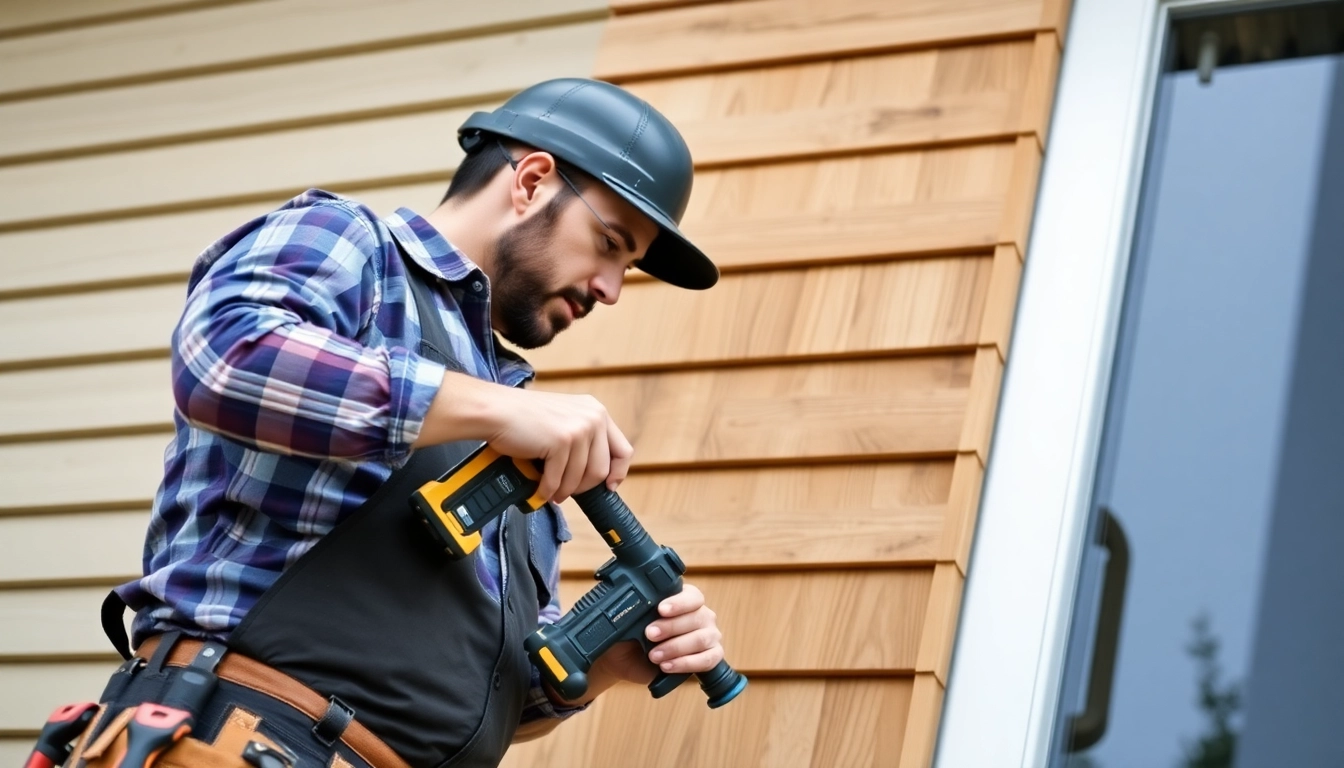Understanding Siding Contractor Services and Their Benefits
When it comes to enhancing the exterior aesthetic, durability, and overall value of your home, investing in quality siding is one of the most effective steps you can take. A skilled siding contractor plays a crucial role in ensuring that your siding project not only meets but exceeds your expectations. Whether you’re considering siding repair, replacement, or new installation, professional siding services provide numerous benefits that impact your home’s longevity, appearance, and energy efficiency. This section explores what a siding contractor does and why their expertise is indispensable for homeowners seeking a reliable and attractive exterior upgrade.
What a Siding Contractor Does and Why It Matters
A siding contractor specializes in the installation, repair, and maintenance of siding materials on residential and commercial structures. Their responsibilities usually cover a broad spectrum, including assessing the existing exterior, recommending the most suitable siding options, preparing surfaces, and executing precise installations. Their work ensures that siding performs as intended—protecting your home from weather elements, improving insulation, and boosting curb appeal.
Why does this matter? Because improper installation can lead to issues such as water infiltration, mold growth, increased energy costs, and premature siding failure. A professional siding contractor understands the intricacies of building codes, manufacturer guidelines, and best practices, ensuring that your siding system is both visually appealing and functionally durable. Choosing a reputable contractor guarantees that the project maintains structural integrity, minimizes future repair costs, and enhances your home’s overall value.
Types of Siding Materials Offered by Pros
One of the key advantages of hiring a siding contractor is access to a wide range of high-quality siding materials, each suited to different aesthetic preferences, budgets, and performance needs. Common options include:
- Vinyl Siding: Popular for its affordability, low maintenance, and versatility. Available in numerous colors and styles, vinyl siding is resistant to pests and weather damage.
- Fiber Cement (Hardie Board): Known for its durability, fire resistance, and attractive appearance. It can mimic wood, stucco, or masonry, providing a versatile exterior solution.
- Cedar Siding: A natural, eco-friendly choice featuring classic aesthetic appeal. Cedar is inherently resistant to decay but requires regular maintenance.
- Metal Siding: Usually made of aluminum or steel, offering excellent durability, modern aesthetic, and easy maintenance. Ideal for contemporary designs.
- Stone and Brick Veneers: For homeowners wanting a luxurious, timeless look, veneers provide the charm of traditional masonry without extensive structural modifications.
Professional siding contractors help you select the best material based on climate, home architecture, budget, and personal style preferences, ensuring a harmonious balance of aesthetics and practicality.
Key Benefits of Hiring a Skilled Siding Contractor
Investing in a qualified siding contractor offers tangible benefits, including:
- Expertise and Quality Assurance: Experienced contractors follow industry standards, reducing installation errors that can compromise siding performance.
- Time and Cost Efficiency: Proper planning and execution streamline the project timeline, avoiding costly rework or delays.
- Access to Premium Materials: Contractors often have relationships with suppliers, allowing access to high-quality, sometimes exclusive, siding options.
- Warranty and Accountability: Licensed professionals typically offer warranties on their work, providing peace of mind and protection against future issues.
- Enhanced Home Value and Curb Appeal: High-quality installation significantly boosts your property’s appearance and marketability.
Overall, a professional siding contractor ensures your investment is protected through meticulous workmanship and reliable service, resulting in a finish that stands resilient for decades.
Choosing the Right Siding Contractor for Your Project
Factors to Consider When Selecting a Siding Professional
The selection process is critical to ensure a successful siding project. Consider the following factors:
- Experience and Credentials: Look for contractors with proven track records, relevant licenses, and industry certifications such as James Hardie Elite Preferred Contractor status or membership in professional associations.
- Local Reputation and Reviews: Check online reviews, testimonials, and word-of-mouth references. A local contractor with positive feedback demonstrates reliability and familiarity with regional building codes.
- Portfolio of Past Work: View completed projects to assess craftsmanship, style, and quality standards.
- Insurance and Licensing: Verify that the contractor carries adequate liability insurance and workers’ compensation to protect yourself from unforeseen liabilities.
- Pricing Transparency: Obtain detailed bids that clearly outline costs, scope, and timelines.
Questions to Ask Potential Siding Contractors
To make an informed decision, prepare a list of questions including:
- How long have you been in business?
- Can you provide references from recent clients?
- What brands and types of siding do you recommend, and why?
- What is the estimated timeline from start to completion?
- Do you handle permits and inspections?
- What warranties are offered on materials and workmanship?
- How do you manage site safety and protect surrounding property?
Evaluating Quotes and Bids Effectively
When reviewing bids, consider not only the price but also the scope of work, materials used, timeline, and contractor reputation. Ask for itemized estimates that break down labor, materials, permits, and disposal fees. Beware of bids significantly lower than competitors, as this could indicate subpar materials or rushed job quality. A comprehensive, transparent bid fosters accountability and helps you compare options fairly.
Best Practices for Siding Installation and Repair
Preparation and Planning for Siding Projects
Successful siding projects start with thorough planning. This includes assessing the current condition of your exterior, identifying underlying issues such as rot or damaged sheathing, and selecting appropriate materials and designs. Prepare your property by clearing the work area, protecting landscaping, and scheduling the project during favorable weather conditions to prevent delays.
Steps in the Siding Installation Process
While specific procedures may vary based on material and project complexity, typical steps involve:
- Inspection and assessment of existing siding and underlying structures.
- Removal of old siding, if necessary, with proper disposal or recycling.
- Repairs to any damaged sheathing, trim, or framing.
- Installation of a weather-resistant barrier or house wrap to prevent moisture intrusion.
- Applying insulation, if part of the upgrade plan.
- Attaching new siding panels securely, ensuring proper alignment and fastening.
- Finishing with trim, moldings, and sealants to enhance aesthetics and prevent water ingress.
- Final inspection and cleanup to leave the site immaculate.
Quality control at each stage is vital to achieving a durable, attractive finish.
Maintaining and Extending the Life of Your Siding
Proper maintenance maximizes the lifespan and appearance of your siding. Key practices include regular cleaning with gentle soap and water, inspecting for damage after storms, and promptly addressing issues like cracks, holes, or warping. Applying protective coatings or sealants can enhance resistance to weathering. Seasonal inspections by professionals can detect and resolve minor problems before they develop into costly repairs.
Cost Considerations and Budgeting for Siding Projects
Average Cost of Siding Installation by Local Contractors
The cost of siding projects varies widely depending on the size of the home, material choice, and project scope. On average, homeowners in the US can expect to pay between $5,000 and $15,000 for a typical siding replacement. For a quality vinyl siding, costs tend toward the lower end, while premium materials like fiber cement or James Hardie siding push prices higher. For instance, a 2,000-square-foot house could see costs ranging from $10,000 to $40,000, depending on the materials selected.
For more detailed insights, see How much does a siding job cost?
Understanding Pricing for Different Siding Materials
Material costs are just one aspect; labor, finishing, and preparation also influence the final price. Vinyl siding typically costs between $2.50 and $10.75 per square foot installed, offering affordability without sacrificing aesthetic options. Fiber cement siding, such as James Hardie, usually runs $7 to $13 per square foot, including installation, reflecting higher durability and aesthetic similarity to wood or masonry.
Knowing these ranges helps homeowners plan budgets and select materials that align with their financial and aesthetic goals.
Tips for Maximizing Value and Avoiding Hidden Costs
To get the best value from your siding project:
- Request detailed, written quotes with clear scope definitions.
- Verify contractor credentials and experience.
- Avoid extremely low bids, which may indicate compromised quality.
- Set aside a contingency fund for unforeseen issues such as hidden rot or structural repairs.
- Consider long-term benefits, including energy savings and reduced maintenance costs.
Effective budgeting and careful contractor selection ensure your siding investment remains cost-effective over its lifespan.
Performance Metrics and Ensuring Quality Results
How to Measure Project Success
Success goes beyond completing the project on time. It includes evaluating:
- Visual quality: even installation, neat finishes, and minimal seams or gaps.
- Structural integrity: siding panels securely attached and properly sealed.
- Weather resistance: absence of leaks or damage after storms.
- Customer satisfaction: homeowner’s comfort, and adherence to initial specifications.
- Longevity: siding’s appearance and performance over time without major repairs.
Implementing periodic inspections and feedback collection can assist in maintaining quality standards.
Common Challenges and How to Avoid Them
Challenges in siding projects often include improper installation, poor material quality, and unforeseen issues like hidden rot. To mitigate risks:
- Select licensed and experienced contractors.
- Use high-quality, industry-certified materials.
- Ensure thorough site assessments and preparation.
- Communicate clearly about project scope and expectations.
- Schedule intermediate inspections during the project.
Proactive planning and transparency with your contractor reduce common pitfalls and ensure lasting results.
Maintaining Siding Durability and Aesthetic Appeal
Regular maintenance routines include washing siding annually, inspecting for damage, and addressing issues promptly. Applying protective coatings every few years enhances resistance to fading, moisture, and pests. For certain materials, avoiding harsh abrasives and using soft cleaning techniques preserves finishes.
Additionally, addressing minor repairs early prevents more extensive damage and extends your siding’s lifespan, maintaining your home’s curb appeal for years to come.




